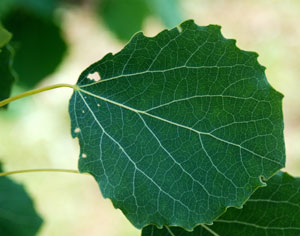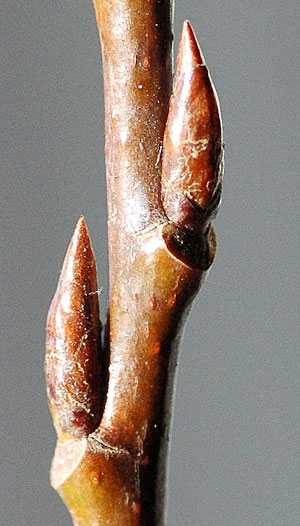Aspen update

Aspens in the United States have been the subject of a number of research studies. The quaking aspen (Populus tremuloides) has been used to
- study intra-specific variation in a tree species - previous studies have focused on quick growing (herbaceous plants), looking at differences in growth, leaf shape /size, and flowering.
- the chemistry of the trees’ defences (tannins)
- The response to rising carbon dioxide levels - the aspens have grown faster.
To add confusion, there is also a European aspen, Populus tremula, which is known as the quaking aspen, like its American counterpart. The ‘quaking’ or trembling of the leaves is due to the nature of the leaf stalk or petiole, which has a flattened shape and is very flexible near to the base of the leaf. The leaves are round with blunt teeth distributed somewhat irregularly around the leaf margin. The leaves of the European Aspen are more coarsely toothed than the American Aspen. Young leaves have a copper tint before becoming green and then in autumn they turn a vibrant yellow before falling. Both American and European quaking Aspen species can spread by suckers that form underground away from the parent tree. The plants so formed are clones, that is they are genetically identical to the parents (ramets).
 This feature means that Aspens are able to quickly colonise an area of open land - e.g. after a fire or clear cutting. As a result, Aspens are sometimes referred to as foundation species as they can have a significant role in shaping the local habitat. They need light and water, and for the first two decades of their life are fast growing, but as the canopy fills out and competition increases so growth slows. They are intolerant of shade, favouring moist soils and open conditions. The trees generally have a life span of some two hundred years but the Pando Clone of P. Tremuloides (in Southern Utah) is not only thought to be the heaviest living organism (weighing over 6000 tons) but also is very old with some estimates suggesting 80,000 years!
This feature means that Aspens are able to quickly colonise an area of open land - e.g. after a fire or clear cutting. As a result, Aspens are sometimes referred to as foundation species as they can have a significant role in shaping the local habitat. They need light and water, and for the first two decades of their life are fast growing, but as the canopy fills out and competition increases so growth slows. They are intolerant of shade, favouring moist soils and open conditions. The trees generally have a life span of some two hundred years but the Pando Clone of P. Tremuloides (in Southern Utah) is not only thought to be the heaviest living organism (weighing over 6000 tons) but also is very old with some estimates suggesting 80,000 years!
The wood is white and light but quite strong; it was used for making oars, paddles and wagon bottoms. The trees attract a variety of insects, including the aspen hoverfly which feeds on micro-organisms in dead wood. The hoverfly lays its eggs in the wet, rotting layer of wood beneath the bark (the cambium) of dead and decaying aspen trees . Here, the larvae feed on the bacteria that break the wood down. A continuous supply of dead wood is essential for the survival of the hoverfly as a species. If dead trees are removed for firewood or the bark of such trees stripped by deer, then these hoverflies lose their ‘homes’ and food source. Deadwood cavities in the trees also provide nesting opportunities for birds, such as the woodpecker. Aspen is a ‘favourite’ building material of beavers.
Comments are closed for this post.
Discussion
Fascinating species. I’ve been following the spread by sucker growth in a new community woodland close to me. I.e. the spread has come from existing woodland on the perimeter of the new woodland area planted on arable ground.
Interested in the strength aspect and will follow up on use within the building trade.

Raised some Clifton Nonpareil caterpillars from eggs a few years back which would happily eat Aspen leaves but NOT from Aspen suckers. Happy with leaves from the parent tree or other individually planted sapplings, so assumed there must be some differences in the leaves that they could detect. Fussy things but an impressive moth when they hatched out. (Large Blue underwing)
Rod Taylor
26 June, 2020